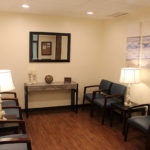Breast cancer is a common form of cancer found primarily in women. In fact, an estimated 1 out of 8 women will be diagnosed with breast cancer at some point in their lives. Breast exams are used to detect breast cancer before it grows and gets worse. There are three ways in which a breast exam can be performed: self-examination, clinical examination, or mammogram.
Self-examinations should begin as early as the teenage years, but by age 20, women should be performing self-breast exams on a regular basis. They take only a few minutes and should especially be performed one week after the start of your period. The first part of a self-exam should be done in front of a mirror. Check the appearance of your breast from multiple angles and note any changes in breast size or shape. Notice if the texture of your skin looks irritated, dimpled, or retracted. The nipples should be checked for fluid discharge. They may also be turned inward or enlarged.
The second part of the exam can be done standing or lying down. You can start with your right breast by raising your right arm and placing your hand behind your head. With your left hand, feel your breast with the tips of your three middle fingers. Search for signs of lumps or masses. These should feel very firm and are usually painless. Squeeze the nipple with you finger and thumb to see if discharge appears. After this, perform the test again on the left breast, reversing the hands you used for the right side. If you have detected any of the symptoms described above, alert Dr. Ayalon as soon as possible for a clinical exam. If you are uncertain about a lump, Dr. Ayalon can help you determine whether or not it is a serious problem.
Clinical breast examinations are performed in Dr. Ayalon’s office. Before the exam begins, you should let Dr. Ayalon know about any changes you’ve noticed in your breasts and share your concerns and questions. Dr. Ayalon will address your concerns, answer your questions, and use any information you provide to help find and identify symptoms of breast cancer. For the exam, you’ll need to undress from the waist up and wear a provided gown. Dr. Ayalon will try to make you feel as comfortable with the examination as possible and only uncover areas of your body when he examines them. These areas include the breasts, armpits, neck, and chest. Dr. Ayalon will use his fingers to check for lumps or masses.
Mammograms are X-rays that are used to identify masses or tumors in the breasts. In this procedure, you will have your breast placed between two plates. The plates compress your breast to get the clearest image possible. This is known to cause discomfort, but will only last for a short moment while the picture is taken. Mammograms can tell if a tumor is present, but not whether it is cancerous or not. However, if a tumor is found in the X-ray image, Dr. Ayalon will move on to the next step in cancer detection, and this early detection can help ensure the best outcome. Dr. Ayalon recommends having a mammogram performed every year for women over 40. Women who have a family history of breast cancer or who are especially at risk for breast cancer should consider earlier screenings.




